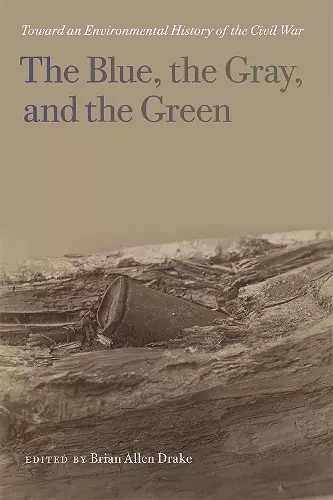The Blue, the Gray, and the Green
Toward an Environmental History of the Civil War
Format:Paperback
Publisher:University of Georgia Press
Published:15th Jan '15
Currently unavailable, and unfortunately no date known when it will be back

Using environmental history to understand the Civil War in new ways
An unusual collection of Civil War essays as seen through the lens of noted environmental scholars, this book's provocative historical commentary explores how nature—disease, climate, flora and fauna, etc.—affected the war and how the war shaped Americans’ perceptions, understanding, and use of nature.
The Blue, the Gray, and the Green is one of only a handful of books to apply an environmental history approach to the Civil War. This book explores how nature—disease, climate, flora and fauna, and other factors—affected the war and also how the war shaped Americans’ perceptions, understanding, and use of nature. The contributors use a wide range of approaches that serve as a valuable template for future environmental histories of the conflict.
In his introduction, Brian Allen Drake describes the sparse body of environmental history literature related to the Civil War and lays out a blueprint for the theoretical basis of each essay. Kenneth W. Noe emphasizes climate and its effects on agricultural output and the battlefield; Timothy Silver explores the role of disease among troops and animals; Megan Kate Nelson examines aridity and Union defeat in 1861 New Mexico; Kathryn Shively Meier investigates soldiers’ responses to disease in the Peninsula Campaign; Aaron Sachs, John C. Inscoe, and Lisa M. Brady examine philosophical and ideological perspectives on nature before, during, and after the war; Drew Swanson discusses the war’s role in production and landscape change in piedmont tobacco country; Mart A. Stewart muses on the importance of environmental knowledge and experience for soldiers, civilians, and slaves; Timothy Johnson elucidates the ecological underpinnings of debt peonage during Reconstruction; finally, Paul S. Sutter speculates on the future of Civil War environmental studies.
The Blue, the Gray, and the Green provides a provocative environmental commentary that enriches our understanding of the Civil War.
A valuable collection of essays by an all-star lineup of scholars, this volume will make an important contribution to environmental history and Civil War history. I know of no other collection that explores so deeply and creatively the intersection of these two fields. This pathbreaking book is imaginative, probing, insightful, and full of surprises. It is certain to intrigue environmental and Civil War historians alike and certain to prompt even more inquiry into the event that, more than any other, has defined the history of the United States.
* co-author of Republic of Nature *The Blue, the Gray, and the Green is the fourth installment in the UnCivil War Series from the University of Georgia Press, which investigates the Civil War in unconventional and fresh ways. Drake’s work is something the subfield of military history should embrace fully, because at times studies on the topic of war can feel ancient. These ten wonderful chapters help re-think the Civil War, bringing the reader not only the minds of great leaders and individual soldiers, but their environment as well.
* Civil War Book Review *This collection of essays successfully demonstrates a need for Civil War environmental history and will appeal to Civil War, environmental, and military historians alike.
* H-Net Reviews *The scholarship throughout this anthology is both rigorous and innovative. The essays invite students of the American Civil War to consider the relevant environmental conditions that shaped the daily lives of those who fought it.
* Michigan War Studies Review *The creatively titled book The Blue, the Gray, and the Green is one of the most exciting collections of scholarship I have read in quite some time. Promising to improve our understanding of the Civil War with insights from environmental history, the authors break new ground and offer tantalizing suggestions for future scholarship. The twelve scholars have succeeded in crafting a work that should be required reading for graduate students and all those interested in expanding the boundaries of Civil War historiography.
* Agricultural History *If Civil War historians want to discover how participants in the past perceived a war fought outdoors, it is past time to immerse Civil War history in nature. Ranging from localized, heavily empirical analysis to broad and imaginative explanations of cultural changes, these essays are a starting point for doing just that.
* The Civil War Monitor *Although the book is not intended to serve as a comprehensive environmental history of the Civil War, it has firmly set itself as the new starting point for scholars who wish to add their own interpretations to what promises to be a thriving and important field of Civil War studies. Any serious scholar of American environmental history or the Civil War must come to terms with both the answers and, more importantly, questions offered by this outstanding volume.
* Environmental History *For Civil War enthusiasts, scholars, and students in any field, these essays demonstrate what historians discover when they bring their keen eyes, experience, and curiosity to places outside their usual stomping grounds. These varied questions and methods of these scholars offer southern historians well-crafted vignettes about various wartime landscapes and communities, including mountains, battlefields, cotton fields, Piedmont tobacco barns, muddy roads, dense second-growth forests, cemeteries, and even deserts.
* Journal of Southern HistoISBN: 9780820347158
Dimensions: unknown
Weight: unknown
264 pages